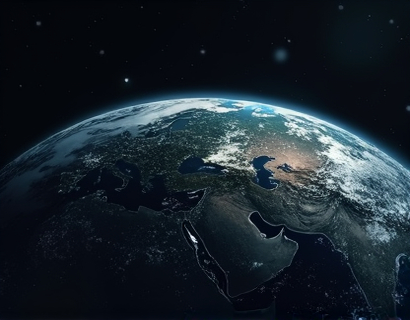Unlocking the Mysteries: Discovering the Intersection of Science and Mathematics
The universe, in all its complexity and beauty, is a vast tapestry woven from the threads of science and mathematics. These two disciplines, often seen as separate entities, are deeply intertwined, each enhancing our understanding of the other. This article delves into the hidden connections between science and mathematics, exploring how complex theories meet real-world wonders, and igniting curiosity while deepening our comprehension of the cosmos.
From the smallest subatomic particles to the largest galaxies, mathematics provides the language through which scientists describe and predict natural phenomena. The elegance of mathematical principles allows us to model the behavior of the universe, from the intricate patterns of snowflakes to the expansive curves of cosmic structures. This interplay is not just a tool for scientists but a source of endless fascination for anyone curious about the workings of the world.
Mathematics as the Language of Nature
The ancient Greek philosopher Plato famously stated that "the universe is written in the language of mathematics." This notion has been echoed through the centuries by numerous scientists and mathematicians. Mathematics is not merely a human construct but a discovery, a set of principles that govern the natural world. The Pythagorean theorem, for instance, is not just a rule for right triangles but a fundamental truth about space and geometry.
In physics, equations are the primary means of describing the behavior of objects and forces. Newton's laws of motion, expressed mathematically, allow us to predict the trajectory of planets and the path of projectiles. The equation E=mc^2, derived from the principles of relativity, reveals the profound connection between energy and mass, a concept that has revolutionized our understanding of the universe.
Mathematics in Biology and Ecology
The influence of mathematics extends beyond physics into biology and ecology. Population dynamics, for example, rely heavily on mathematical models to predict the growth and interactions of species within ecosystems. The logistic growth model, a differential equation, helps ecologists understand how populations change over time, considering factors like resource availability and environmental constraints.
In genetics, the double helix structure of DNA is a mathematical marvel. The spiral staircase of genetic information is described using mathematical concepts such as groups and symmetries. The field of bioinformatics uses algorithms and statistical methods to analyze and interpret biological data, from gene sequences to protein structures, enabling breakthroughs in medicine and biotechnology.
Mathematics in Chemistry and Materials Science
Chemistry, the study of matter and its transformations, is deeply rooted in mathematics. The periodic table, a cornerstone of chemistry, is organized based on the atomic number, a mathematical concept that reveals the underlying structure of elements. Chemical reactions are governed by laws that can be expressed mathematically, allowing chemists to predict reaction rates and equilibrium states.
In materials science, mathematical models help design new materials with specific properties. Crystallography, the study of crystal structures, relies on group theory and other advanced mathematical concepts to understand the arrangement of atoms in materials. This knowledge is crucial for developing advanced materials used in electronics, aerospace, and medicine.
Mathematics in Astronomy and Cosmology
Astronomy and cosmology are fields where mathematics plays a pivotal role in unraveling the mysteries of the universe. The motion of celestial bodies is described using celestial mechanics, a branch of physics that employs mathematical techniques to predict orbits and gravitational interactions. Kepler's laws of planetary motion, for example, are mathematical descriptions of the elliptical orbits of planets around the sun.
Cosmology, the study of the large-scale structure and evolution of the universe, relies heavily on mathematical models. The Big Bang theory, which describes the origin and expansion of the universe, is based on complex mathematical frameworks including general relativity and quantum field theory. The cosmic microwave background radiation, a remnant from the early universe, is analyzed using statistical methods to infer the conditions of the early cosmos.
Mathematics in Climate Science and Environmental Modeling
Climate science is another area where mathematics is indispensable. Climate models, complex systems of equations, simulate the Earth's climate system, incorporating factors such as atmospheric dynamics, ocean currents, and land surface processes. These models help scientists understand and predict climate change, providing critical insights for policy-making and environmental management.
Environmental modeling uses mathematical techniques to assess the impact of human activities on ecosystems. Pollution dispersion models, for instance, use partial differential equations to predict how pollutants spread in the atmosphere and water bodies. This knowledge is essential for developing strategies to mitigate environmental damage and protect natural resources.
Interdisciplinary Connections
The intersection of science and mathematics is not limited to specific fields but extends to interdisciplinary research. For example, computational biology combines mathematics, computer science, and biology to simulate biological processes and understand complex systems. Machine learning algorithms, rooted in mathematical statistics, are used to analyze large datasets in genomics, proteomics, and other areas of biological research.
In physics, mathematical tools such as tensor calculus and differential geometry are essential for understanding phenomena like black holes and the fabric of spacetime. These concepts, while abstract, have practical applications in GPS technology, which relies on precise time measurements affected by gravitational fields.
Educational Implications
The deep connection between science and mathematics has significant implications for education. Teaching these subjects together can enhance students' understanding and appreciation of both fields. Integrative curricula that highlight real-world applications and interdisciplinary projects can inspire a new generation of scientists and mathematicians.
Moreover, fostering a curiosity-driven approach to learning encourages students to explore the beauty and utility of mathematics in solving scientific problems. This approach not only improves mathematical skills but also cultivates a broader scientific literacy, preparing students to tackle complex challenges in the future.
Conclusion
The intersection of science and mathematics is a rich and dynamic field, offering endless opportunities for discovery and innovation. By recognizing the profound connections between these disciplines, we can deepen our understanding of the universe and address some of the most pressing challenges of our time. Whether through the elegance of a mathematical proof or the precision of a scientific experiment, the union of science and mathematics continues to illuminate the path forward, guiding us toward a more informed and curious world.










































